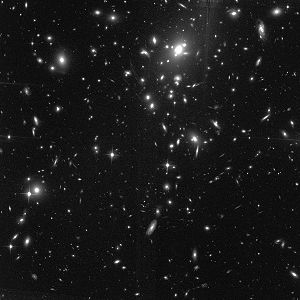
|
| The galaxy cluster Abell 1835 behind which the galaxy Abell 1835 IR1916 was discovered. Distance 4000 mega parsecs (13.23 billion years at the present local speed of light). |
Starlight and the Heavens
Daniel Gregg
Introduction

|
| The galaxy cluster Abell 1835 behind which the galaxy Abell 1835 IR1916 was discovered. Distance 4000 mega parsecs (13.23 billion years at the present local speed of light). |
Very often we have to hear rejection of the scriptural fact that the stars were made on the fourth day of creation. This takes the form of claiming that the speed of light is a universal constant of relatively low speed with respect to cosmic distances, so that starlight could never make it to Earth in the short time the Scripture provides. For instance, if the light from galaxy Abell 1835 IR1916, which is 4000 mega parsecs away had to travel all the way to Earth at only the locally measured speed of light on Earth, then it would take 13.23 billion years!
This argument is based on the assumption uniformitarianism or gradualism. It takes a currently, and locally, measured speed of light and extrapolates this assumption backward in cosmic history, and outward into present space beyond any ability to actually confirm the assumption. This is assumed despite the fact that man has only measured the local two way speed of light. The two way speed is obtained by timing a light signal to a reflective surface or transponder and waiting for it to return. The one way speed cannot be measured because there is no way to calibrate two separated clocks. So the longest measurement has been between the Pioneer 10 and 11 space probes and Earth, and even those measurements are considered anomalous since the actual position of the spacecraft does not agree with the timing of the signals sent to them. The Pioneer data are actually evidence that the speed of light is not constant, and that it actually crosses the distance faster. More on that later.
The unbelieving
establishment seeks to maintain this constant light speed assumption by academic intimidation,
subtle suggestion, peer review, or persecution of those who would question it, and by
defining fundamental physics so that it must incorporate this assumption into
the mathematics of physics. In the
service of keeping this assumption, distance and time are redefined by the
Einstein's gamma
transformations. Gamma refers to a factor by which either time or length
must be modified in order to keep the speed of light from changing:
 . Steven
Bryant, a mathematician exposes a fundamental error in Einstein's 1905 paper.
It only takes a knowledge of basic high school algebra to verify that Bryant is
correct. Link.
Bryant shows that all the follows after this error concerning Special Relativity is now in
question, and that includes the length contraction and time dilation formulas.
The inconsistency of these formulas in Special Relativity has also been shown by
others.
. Steven
Bryant, a mathematician exposes a fundamental error in Einstein's 1905 paper.
It only takes a knowledge of basic high school algebra to verify that Bryant is
correct. Link.
Bryant shows that all the follows after this error concerning Special Relativity is now in
question, and that includes the length contraction and time dilation formulas.
The inconsistency of these formulas in Special Relativity has also been shown by
others.

The formula at the left redefines length in one frame of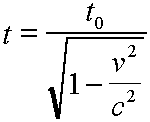 reference to be equal to a different length in another frame of reference that
is moving with respect to the first frame of reference. "v" is the velocity
difference between the two frames. "c" is the speed of light.
The second formula at the right redefines time in one frame of
reference to be equal to time modified by the gamma factor in another moving frame of
reference. And then relativists tell us that it does not matter
which frame of reference is considered to be moving. A little
algebraic manipulation is all that is needed with this last assumption to show a
mathematical contradiction. But because of the hero worship of Albert
Einstein, his devotees refuse to see it.
reference to be equal to a different length in another frame of reference that
is moving with respect to the first frame of reference. "v" is the velocity
difference between the two frames. "c" is the speed of light.
The second formula at the right redefines time in one frame of
reference to be equal to time modified by the gamma factor in another moving frame of
reference. And then relativists tell us that it does not matter
which frame of reference is considered to be moving. A little
algebraic manipulation is all that is needed with this last assumption to show a
mathematical contradiction. But because of the hero worship of Albert
Einstein, his devotees refuse to see it.
 Furthermore, space is curved and bent using the justification of
non-Euclidean geometry. Euclidean geometry is what people normally think
of, having three dimensions, length, width and height, oriented in space at
right angles. In non-Euclidean geometry the method of measuring distance
is allowed to vary, and then it is assumed that this geometry with a varying
distance can be embedded in some imaginary higher dimensional space so that the
changing distances are really considered the same. If this sound like a
bunch of confusion to you, then that is the point. The point is to confuse
people into thinking that valid comparisons can be made without an absolute
distance to measure things by.
Furthermore, space is curved and bent using the justification of
non-Euclidean geometry. Euclidean geometry is what people normally think
of, having three dimensions, length, width and height, oriented in space at
right angles. In non-Euclidean geometry the method of measuring distance
is allowed to vary, and then it is assumed that this geometry with a varying
distance can be embedded in some imaginary higher dimensional space so that the
changing distances are really considered the same. If this sound like a
bunch of confusion to you, then that is the point. The point is to confuse
people into thinking that valid comparisons can be made without an absolute
distance to measure things by. Henri Poincaré (1854-1912) was the master of this sort of geometry. The Poincaré disk at the right illustrates this. All the blue
octagons are supposed to be the same size. As you can see, they shrink as
one approaches the edge of the disk. Actually, in this non-Euclidean
geometry one can never reach the edge of the disk. The distance shrinks
proportionally depending on how far away the measurement is made from the
center. The number of blue octagons multiplies to infinity as one
approaches the edge. This is all fine and dandy as long as one admits the ruler
is a stick of Jell-O for fancy Escheresque art work. But relativists want to borrow
this geometry, put it into a so called higher dimension and then expect us to
believe that the octagons in this higher space are all the same size!
Therefore, a standard of universal time is dismissed,
and a fixed length for measurement is turned into a yard-stick of Jell-O that
changes length when it is moving. The fact is that true science cannot be
done with a broken clock and a bent ruler. Yet that is what the
cosmological religion of relativity has given the world. The 20th
century has seen the establishment of a new world cosmological religion based on
evolution and relativistic physics.
Henri Poincaré (1854-1912) was the master of this sort of geometry. The Poincaré disk at the right illustrates this. All the blue
octagons are supposed to be the same size. As you can see, they shrink as
one approaches the edge of the disk. Actually, in this non-Euclidean
geometry one can never reach the edge of the disk. The distance shrinks
proportionally depending on how far away the measurement is made from the
center. The number of blue octagons multiplies to infinity as one
approaches the edge. This is all fine and dandy as long as one admits the ruler
is a stick of Jell-O for fancy Escheresque art work. But relativists want to borrow
this geometry, put it into a so called higher dimension and then expect us to
believe that the octagons in this higher space are all the same size!
Therefore, a standard of universal time is dismissed,
and a fixed length for measurement is turned into a yard-stick of Jell-O that
changes length when it is moving. The fact is that true science cannot be
done with a broken clock and a bent ruler. Yet that is what the
cosmological religion of relativity has given the world. The 20th
century has seen the establishment of a new world cosmological religion based on
evolution and relativistic physics.
It is a religion that believes the universe has no center, and no unique places. It denies that Earth is the privileged planet at the center of creation with mankind created in the image of God at the pinnacle of creation. We will see that the scientific evidence on the speed of light does not support their argument in this paper. The facts are well known, but the correct interpretation has been hidden by the fog of Einstein's theory of relativity. Relativity is well named, because it does away with the absolute measurement of time and the fixed measurement of distance.
A Decelerating Speed of Light
Local facts about the speed of light have been swept under the rug. First there is a statistically valid decrease in the speed of light, starting from its original measurement's in the 1600's. This is explained by creation scientist Barry Setterfield, mathematician Alan Montgomery, and Physicist Lambert Dolphin. This discovery began with Setterfield's landmark paper: The Atomic Constants, Light and Time. It demonstrates a significant trend in the historical measurement data toward of a decreasing speed of light. See the History of the speed of light by Helen Setterfield.
With the invention of the atomic clock scientists stopped measuring light speed with orbital clocks.
(An orbital clock is one based on the movement of the sun, moon, or stars, and
depends on the speed of gravity, which is much faster than light. ( ).
Because they stopped using orbital clocks, experimenters were no longer able to
detect changes in the speed of light. It is also known that the
speed of gravity is much greater than the speed of light. The
relativistic cult denies this, but it has been conclusively proven that
gravitational systems are unstable without a speed of gravity many orders of
magnitude above that of light. Professional astronomer Thomas Van Flandern explains that the
Speed of Gravity is is at least 10 orders of magnitude above that of light in is
paper, The
Speed of Gravity What the Experiments Say. The relativists do
not like these results, because their dogma dictates that the local speed of
light must be the ultimate speed limit of all information in the universe.
).
Because they stopped using orbital clocks, experimenters were no longer able to
detect changes in the speed of light. It is also known that the
speed of gravity is much greater than the speed of light. The
relativistic cult denies this, but it has been conclusively proven that
gravitational systems are unstable without a speed of gravity many orders of
magnitude above that of light. Professional astronomer Thomas Van Flandern explains that the
Speed of Gravity is is at least 10 orders of magnitude above that of light in is
paper, The
Speed of Gravity What the Experiments Say. The relativists do
not like these results, because their dogma dictates that the local speed of
light must be the ultimate speed limit of all information in the universe.
Setterfield's graph below shows how several curves might be fit to the historical measurements of the speed of light, showing a significant trend to decrease. Due to size constraints, it is placed sideways.
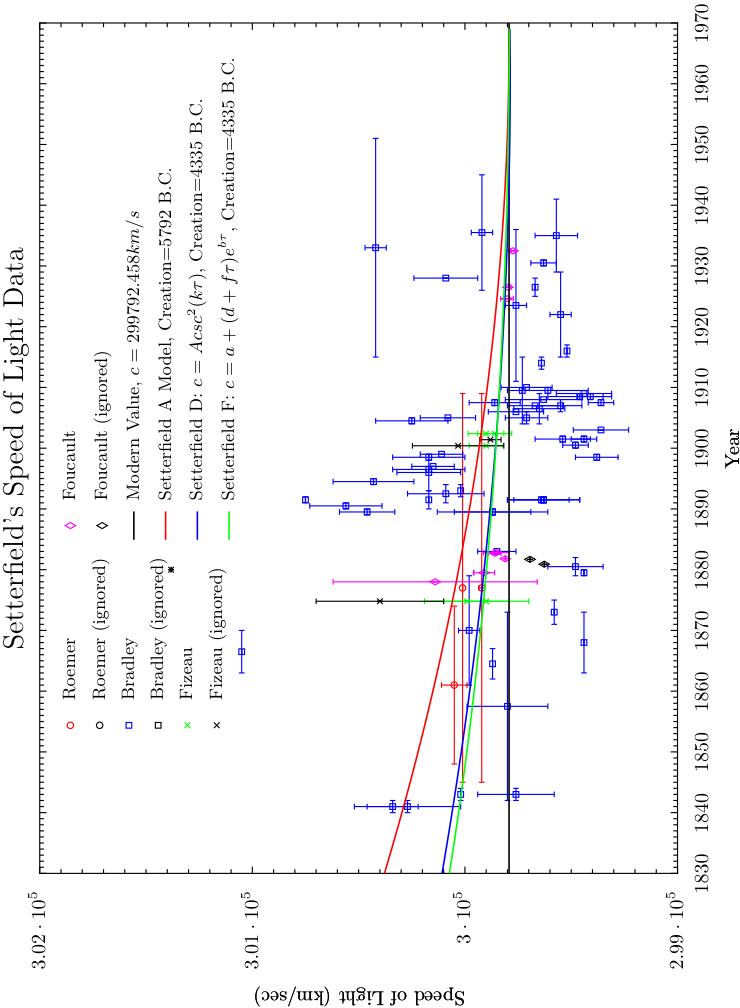
The next graph is Setterfield's extrapolation back toward creation of the speed of light curve.
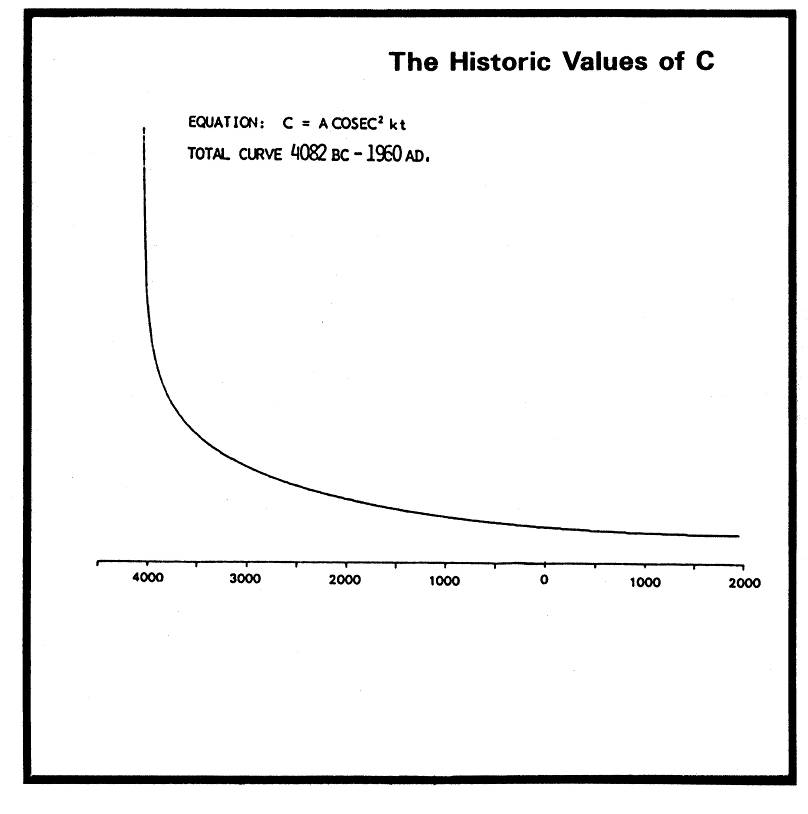
One will see that this assumed a creation date of 4082 B.C. Actually, one can fit a curve for almost any creation date. I chose this graph because it is close to the true creation date of 4140 B.C. Unfortunately, in his later work Barry fits the data for the Septuagint dates. The extra time that the Septuagint provides is not needed. Further the Greek Septuagint is clearly inferior to the Hebrew Masoretic Text, which is the original. See The Scroll of Biblical Chronology and Prophecy on this website, which shows the complete solution to the puzzle of Biblical Chronology. These historical and biblical data override all speculative arguments from physics that would ignore the concept of the 'economy of miracles' or 'the complexity understanding of parsimony principle'. These articles give my views on Ockham's Razor and the place of divine intervention in the normal physics of the world. I urge you to read these articles as they will deliver you from faulty thinking on how to judge the value of a theory, or how to determine what is probably true.
The extrapolation of physics ideas into the past must be constrained by the biblical record even if it leads to the conclusion that God intervened in affairs more than we might have thought. Setterfield's later calculations show understanding of these principles in that he has modeled his ideas according to major turning points in Biblical history. (It is just unfortunate that he used the Septuagint.) Here the indications of historical intervention are included:
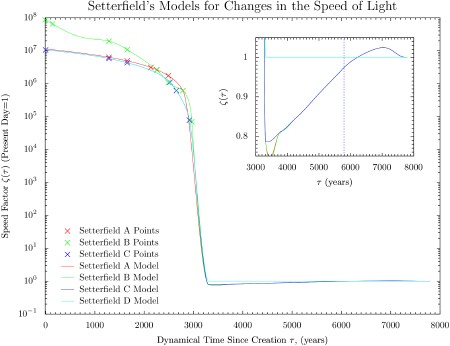
Sorry about the poor quality of the image. Take note of the steep drop in the curve. This corresponds to the time of the flood (2484 B.C.). The LXX pushes the flood back another thousand years. We can ignore this error for the moment. Notice that the light speed deceleration curve flattens out after the flood. However, there is a problem with Setterfield's theory that we have to discuss, although the idea is promising, and in a final theory some element of it will be retained.
Supernova 1987A and the Speed of Light
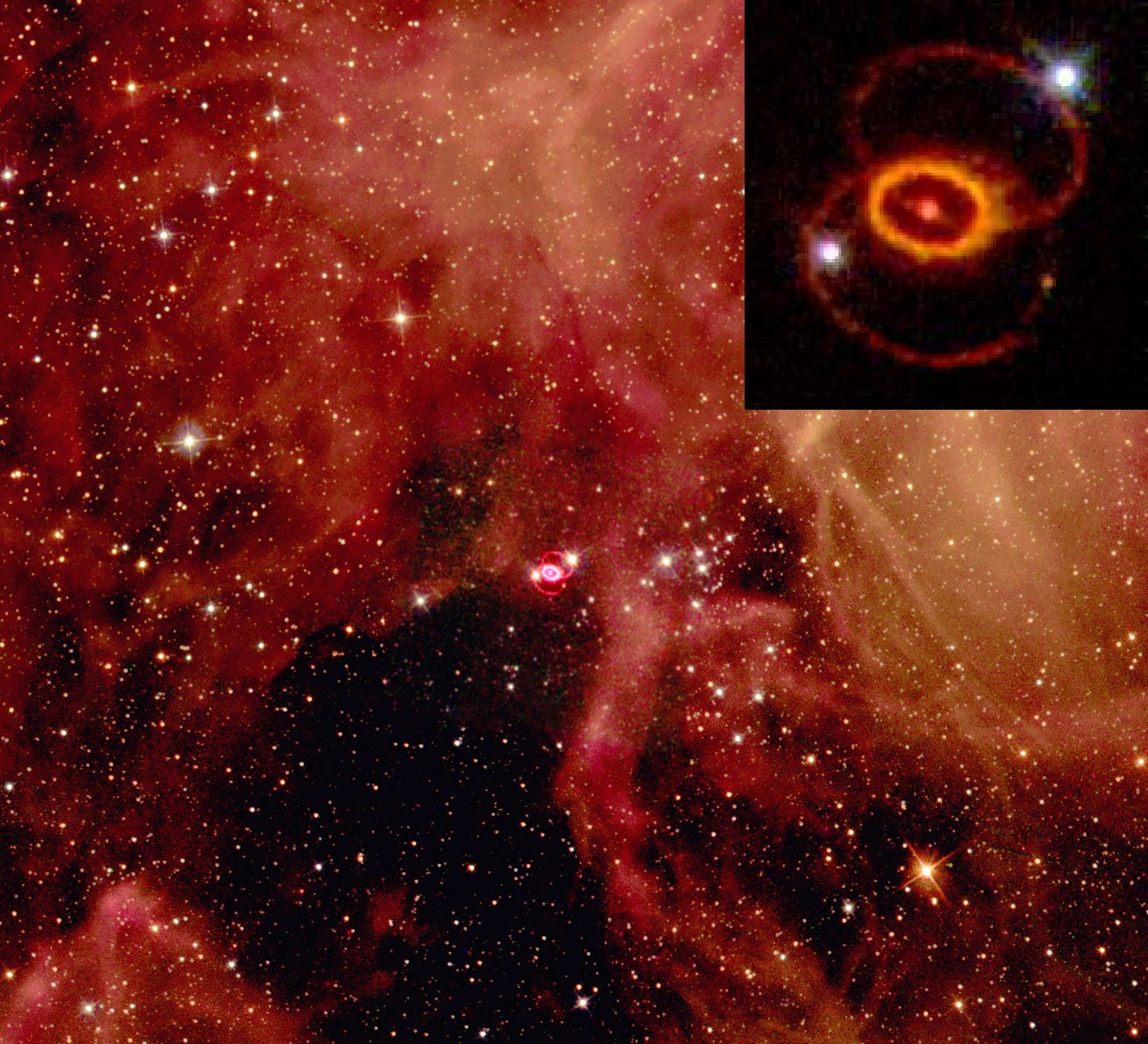
SN 1987A was a supernova in the outskirts of the Tarantula Nebula in the Large Magellanic Cloud, a nearby dwarf galaxy. It occurred approximately 51.4 kiloparsecs from Earth [1], close enough that it was visible to the naked eye. It could be seen from the Southern Hemisphere. It was the closest observed supernova since SN 1604, which occurred in the Milky Way itself. The light from the supernova reached Earth on February 23, 1987. If the light had to travel at the local speed on light on Earth it would have taken 167,564 years to arrive. Since the star exploded sometime after creation, the interstellar speed of light was greater.
This supernova is named 1987 because it was observe to explode in 1987. How long before 1987 did it explode? No more than 6148 years. In order to show how this may happen we have to solve a problem with Setterfield's theory.
The problem is that if the speed of light slowed down, then we would be seeing events far away in slow motion. This problem is admitted by Setterfield and also by Walt Brown, who reviews Setterfield's theory in his book, In the Beginning. Think of light as bits of visual information leaving a source. If each subsequent bit of information is a little slower than that before it, then the later bits would fall behind the first bits. The first bits would reach the observer quickly, starting the picture, but the later bits would seem to arrive late, so the observer would see events far away in 'slow motion'. Brown says:
A Critical Test. If the speed of light has decreased a million fold, we should observe events in outer space in extreme slow motion. Here is why.
Imagine a time in the distant past when the speed of light was a million times faster than it is today. On a hypothetical planet, billions of light-years from Earth, a light started flashing toward Earth every second. Each flash then began a very long trip to Earth. Because the speed of light was a million times greater than it is today, those initial flashes were spaced a million times farther apart than they would have been at today’s slower speed of light.
Now, thousands of years later, imagine that throughout the universe, the speed of light has slowed to today’s speed. The first of those light flashes—strung out like beads sliding down a long string—are approaching Earth. The large distances separating adjacent flashes have remained constant during those thousands of years, so the moving flashes slowed in unison. Because the first flashes to strike Earth are spaced so far apart, they will strike Earth every million seconds. In other words, we are seeing past events on that planet (the flashing of a light) in slow motion. If the speed of light has been decreasing since the creation, then the farther out in space we look, the more extreme this slow motion becomes.
About half the stars in our galaxy are binary. That is, they and a companion star are in a tight orbit around their common center of mass. If there is a “slow-motion effect,” the apparent orbital periods of binary stars should tend to increase with increasing distance from Earth. If the speed of light has been decreasing, the Hubble Space Telescope may eventually find that binary stars at great distances have very long orbital periods, showing that we are observing them in slow motion. Source.
All the observations of astronomers have merely confirmed that motion in the heavens occurs at normal rates, at least in the current epoch of observation. Therefore, the test for slow motion is coming up with a continuous null result. Setterfield's theory will only be useful if we can eliminate the slow motion effect in the theory, because the theory leads to the that conclusion.
Dynamically Varying Speed of Light
I also think that light speed varies after leaving the the source, but this is a different effect than the historical deceleration of light discussed above. Setterfield's theory will be retained in that the speed of light has probably slowed down some, but I think this is a local and relatively short range effect over historical time. For getting information across vast distances we need a new idea.
First a quanta of light is emitted at the source at the current local speed of light. It remains at this speed for some distance large enough to separate it well away from the star system. Then it accelerates rapidly to a near infinite speed in interstellar space as the star's gravitational field drops off to near zero, or below some critical value causing light to react exponentially. Light may gain speed either continuously at this point, or in large quantized steps. Whenever it passes near or into another star system, it slows until it reaches the local speed of light just as it enters the star system's planetary space. Setterfield's idea on the historical deceleration of the speed of light can be applied when the light is at its slower speed inside a star system. Let us consider a bubble around a star, called the 'slow zone'. At creation, the bubble is small, say just outside the orbit of Pluto, such that light accelerates exponentially outside the orbit of Pluto. But also time passes, the local speed of light decays and the bubble grows. Theoretically this bubble can grow up to 6148 light years, intersecting with the bubbles of all the nearby stars. Or it may only be a light day, light week or month. Now let us discuss some of the evidence for the idea that light dynamically changes speed in the current epoch.
Shapiro Delay
Mariner 7 Space Probe

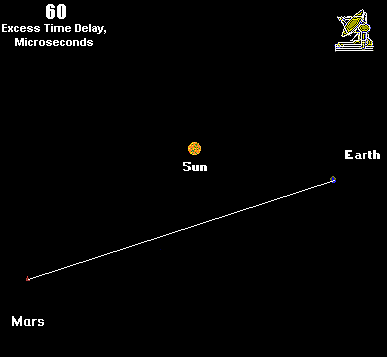
It has been shown when light passes near the sun that it slows down. This effect is called Shapiro Delay, discovered by Irwin Shapiro. This effect was tested by sending signals between space probes (like Mariner 7 above) orbiting Mars, and Earth. Some of the signals were sent when the sun was not near the path of the signal, and some when it was. They were compared. The space probe's position was gravitationally computed. It was found that light speed slows near the sun, and is faster away from the sun. A possible cause for interstellar acceleration of light speed might be to extend the Shapiro function by breaking it into stepwise changes. The experimentally verified effect is good for regions near stars, but then as gravity drops off outside of star systems, the effect may take on an exponential character when the star's gravity field reaches a critical low point.
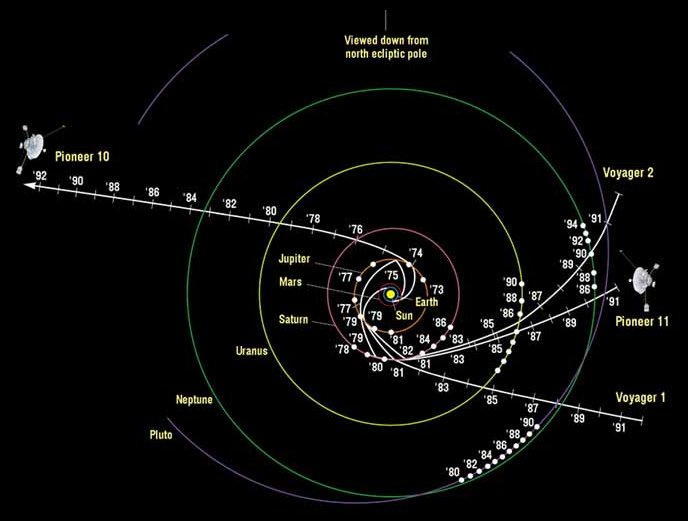
It is also known that there is a discrepancy between the position of the Pioneer 10 and 11 spacecraft and the round trip time for light speed signals to travel the distance. It is called the Pioneer Anomaly. The anomaly was a small acceleration component back toward the sun. The spacecraft did not seem as far away as they should be! In fact it has gone "off course" toward the sun, over the years by more than 250,000 miles! Why might this be? Could it be that the speed of light was fractionally faster farther from the sun's gravity well? Could it be that the Shapiro function is more complex than known and that it begins to give different results farther out? Possibly. The anomaly is not a real acceleration, but merely an artifact of assuming the light speed used to measure the distance is a constant besides assuming that the Shapiro effect remains invariant. The Shapiro effect shows that the speed of light varies. A varying Shapiro effect would show that the rate of variation can also vary. In fact, light covers the distance faster than expected, and so the distance seems less than it should be, hence the anomalous acceleration toward the sun. In reality, the distance is just what it is calculated to be by other means, and light does cover the distance fractionally faster. Moreover, all of the spacecraft we have sent far out that don't wiggle too much are showing the same anomaly to the same degree. These space probes are actually the largest speed of light experiment ever conducted, and the result for testing the constancy of the speed of light is NULL.
The only thing preventing the physics world from accepting this is their devotion to Einstein's ideas, which is what they wanted to hear. Einstein only made it easier with his 1905 paper, which contains critical errors. Also, little known, is the fact that the Michelson-Morley experiment (MMX) on the speed of light was not zero. The result was that light differed by 8 km/sec, and 0 km/sec is not even in the 99.9% confidence interval:
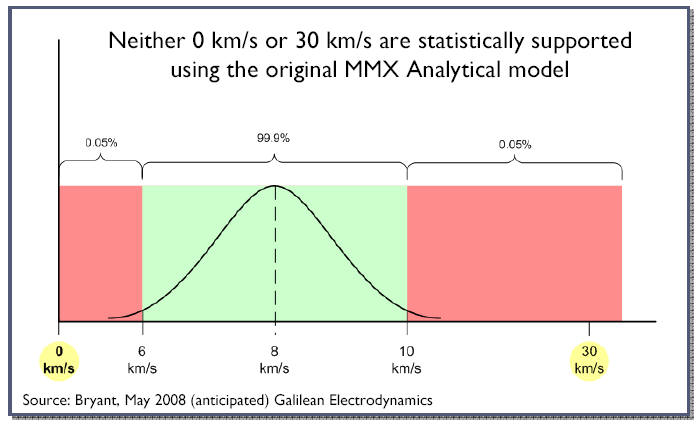
Also, the atomic clocks on
GPS (Global Positioning System) satellites run faster than the same clocks on earth.
NASA Engineers
have to compensate for this effect by setting the clocks slow on earth just
before launch. This can only happen if the speed of light that governs the
'ticking' of the atomic clock is faster when the spacecraft is in orbit.
And, it has been shown that when one flies an atomic clock around on a jet and
compares it to a ground clock that the jet clock runs slow.
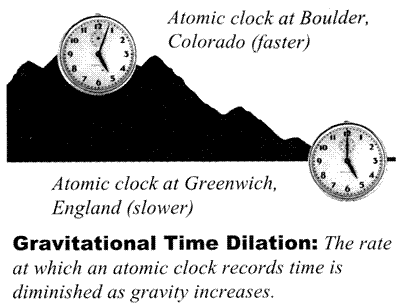 Also, it
has been shown that an atomic clock on a mountaintop runs faster than one at low
altitude. The Einstein cult of General Relativists tries to explain
that space bends and time dilates. They use some fancy extra
dimensional mathematics (beyond the normal three of length, with, and height) to
impress us enough to believe such oxymoronic statements about space and time.
Here is the normal mathematics: algebra, geometry, calculus, statistics,
probability, and vectors up to three dimensions. But half way through
linear algebra, topology, and tensors, things get crazier and crazier.
For example, linear algebra introduces dimensions higher than the normal
three. The fact is that these are not dimensions at all that have anything
to do with the real world, yet students get into the habit of referring to them
as such. From there to the bending of space one is in free fall.
It is all imagination and imaginary. Despite all these shenanigans, the
atomic clock in Colorado runs faster than the one in England. The clocks
are different because one runs physically slower than the other.
Time dilation has nothing to do with it. Gravity just makes the
lower clock tick slower.
Also, it
has been shown that an atomic clock on a mountaintop runs faster than one at low
altitude. The Einstein cult of General Relativists tries to explain
that space bends and time dilates. They use some fancy extra
dimensional mathematics (beyond the normal three of length, with, and height) to
impress us enough to believe such oxymoronic statements about space and time.
Here is the normal mathematics: algebra, geometry, calculus, statistics,
probability, and vectors up to three dimensions. But half way through
linear algebra, topology, and tensors, things get crazier and crazier.
For example, linear algebra introduces dimensions higher than the normal
three. The fact is that these are not dimensions at all that have anything
to do with the real world, yet students get into the habit of referring to them
as such. From there to the bending of space one is in free fall.
It is all imagination and imaginary. Despite all these shenanigans, the
atomic clock in Colorado runs faster than the one in England. The clocks
are different because one runs physically slower than the other.
Time dilation has nothing to do with it. Gravity just makes the
lower clock tick slower.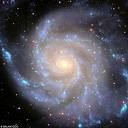
Someone might say that
gravity cannot be the explanation for speeding starlight. Well assuming
what we know about the local properties of gravity, this may be so.
But do we know all the properties of gravity? It is well known that
with galaxy sized objects, the stars therein do not obey the laws of gravity as
we mathematically describe them in the solar system. In fact,
astronomers have proposed MOND, Modified Newtonian Dynamics, which is nothing
less than a re-writing of the gravitational law to explain observations that do
not fit the locally known law. The stars rotating about a galactic core in
one of the arms accelerate faster than in normal Newtonian Gravity. This
way they keep pace with the inner stars, and the pretty picture is preserved.
If the stars obeyed Newton's law, then the galaxy would turn into a scrambled
hodgepodge after a few turns.
I clipped the image Gravitational Time Dilation above to illustrate the clock difference. The attempt in the caption to get you to think that time is relative is diabolical, "the rate at which an atomic clock records time ...." You can bet the bank that one of these clocks is just fast and the other slow. One clock is just more inaccurate than the other when compared to absolute time, and that can only be judged by comparing them with an accurate orbital clock.
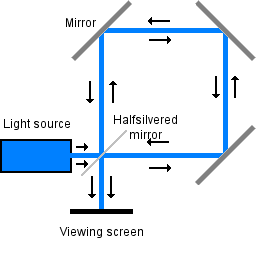 |
| Schematic representation of a Sagnac interferometer on a rotating platform. Light takes different times to go clockwise or counter clockwise around the table when it rotates. |
Then there is the Sagnac effect. It turns out that on a
rotating platform light rays will have different travel times depending on the
rate of the platform's rotation and whether the ray is sent around the platform
against the rotation or with the rotation. The best explanation is
that the speed of light varies with respect to its absolute motion in the frame
of Earth's gravitational field. The effect has been used to develop
special light gyroscopes which use light to detect whether the gyroscope is
rotating in the local gravitational field. If the light speed did
not vary, then the gyroscope would not work at all. Yet the Einstein
cult pulls out the fancy mathematics and expects us to believe its decrees that
no one can visualize, not even they apparently.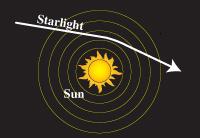
What about Einstein? We should not be intimidated by Einstein just because unbelief was ready to embrace him when he offered explanations it liked. Einstein's theory did predict that light would bend more than classical physics when coming round the sun. (Though there is some dispute as to whether he plagiarized the prediction.) This bending of the light ray was demonstrated by Eddington during the observation of a solar eclipse. The light takes a curved path around the sun in Euclidean space. But what does it mean for light at constant velocity to take a curved path? It means that the light must accelerate. And acceleration means only one thing. The velocity of light was not constant. The very definition of velocity is displacement over time. A constant velocity is a constant displacement over time. If the displacement changes with time, then the velocity is no longer constant, and the object is said to be accelerating.
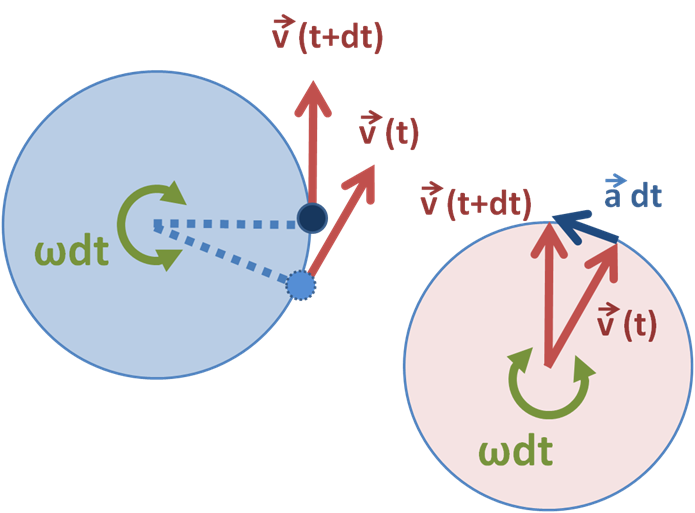
Any first year physics student knows that any object that travels a curved path is accelerating. There is no reason why a light photon should be excluded from the conclusion that it accelerated when it went around a curve. Einstein thought of a way to get around this inconvenient fact. Einstein used fuzzy non-Euclidean geometry (developed by Gauss, Lobachevsky, Bolyai, Poincaré, and Minkowski) and changing the standards math (called the Lorentz Transformation) to keep the velocity of light constant for Unbelief. He curved the space, bent the ruler, and broke the clock to do it. Why was his theory successful then? Well for a time, if you bend your ruler, and break your clock, you can make any theory fit the facts, at least most of the facts, and it helps if you invent the Atomic Bomb (or make the public think you get credit for it) at the same time to win the last major war. Some facts become inconvenient and are ignored by the Establishment. Nevertheless, Einstein's special relativity, which is abbreviated SR, leads to logical contradictions, while Lorentzian Ether Theory (LET) and other alternatives do not. The latter explains all the evidence without the contradiction. (The Ether part, however, has not been observed.) And even though Lorentz co-invented the fuzzy math, he did not agree with Einstein's SR equivalence principle.
No we need not be bamboozled by the Einstein cult. They are in fact the high priests of the coming world religion. The new Babylon will be be like the old one, with ziggurats and pyramids to the heavens (telescopes and observatories). Observing the heavens for the glory of God is a good thing, but when combined with unbelief all the instruments of astronomy simply become the temples of the new astrology, with its Big Bang, un-centered universe, and boundless, edgeless creation with no heaven.
Now it is true that atomic clocks run slow or fast depending on their position in a gravitational field or depending on their velocity. So it is clear that such clocks do not keep absolute time. Lorentzian relativity will tell us just how much fast or slow they might run just as well as SR. But in absolute time, those clocks run absolutely slow or absolutely fast. SR denies this, and because it compromised with Unbelief, it came out with a host of wrong predictions about whether the GPS system would work at all. See Thomas Van Flandern's (1940-2009). This is because SR says that when two clocks are moving away from each other at constant velocity in a straight line, without gravity being a factor, that if clock A regards itself as stationary, then clock B runs slow. But if clock B regards itself as stationary and clock A as moving, then clock B is entitled to regard clock A as running slow. The only way to get such a result is with a broken clock and a bent ruler. But rather than admit to the bent ruler and broken clock, SR claims that both A and B's claims on the slowness of the other clock are equally true. But if we ask absolute time and absolute length what is the truth, we will get one answer. One clock runs absolutely slow and the other runs absolutely fast.
Some secular cosmologists have become heretics from consistent Unbelief. They have proposed VSL (varying speed of light) theories at the beginning of the Big Bang. (There was no 'Big Bang' because God created the Earth first.) Nevertheless, for some reason they wanted to break with the foundational religious tenet of unbelief: the speed of light does not change. Apparently even they are not entirely happy with the religion that brought them up, a religion invented for the purpose of countering the Biblical revelation.
Is a faster speed of light the most likely explanation for seeing starlight in creation that is only 6148 years old? Here are the alternatives with comments:
The speed of light exponentially was faster in the past. {This must be combined with other options below to overcome the 'slow motion' effect.}
The Sun, moon, and Earth were held in a state of suspended animation until such time as starlight arrived from the farthest heavens. {Whether one says that cosmological clocks run faster or Earth clocks slower is a matter of equivalence. In neither case is actual time dilation involved. Time can be held conceptually constant. The rates of physical processes can change.}
Light is emitted at a slow speed, accelerates exponentially to cross vast distances, and then decelerates to arrive at its absorption point at a slow speed. {This is the dynamically varying speed of light that I proposed.}
Light speeds up at some distance greater than our ability to observe the increase after leaving the source. The velocity is comparatively infinite then. It is absorbed at this high velocity with no ill effects, but if re-emitted does not attain that velocity again until it is left undisturbed for some distance greater than our ability to measure. {While this theory might work, I don't like it because it lacks symmetry.}
A combination of the first alternatives.
Light was created enroute. [This theory leads to the conclusion that we see events that never happened at their source].
Running the cosmos at a different clock rate than Earth's star system, if taken alone, leads to the disadvantageous effect that while starlight is seen on earth with very little clock time on earth, the light emitted by the sun is not seen in the cosmos, because the local light is slow with respect to the incoming cosmic light. It seems we must have a faster speed of light to allow the Earth's star system to be seen beyond 6148 light years.
Understanding Red Shift
The light from a candle, star, galaxy, glowing gas cloud, or from any source emitting visible light can be analyzed with a glass prism or diffraction grating. The prism is the easiest to understand. The figure shows white light separated into the colors of the rainbow by a glass prism. The same effect occurs through raindrops to create a rainbow. Crystals, compact disks, windows, and other everyday objects can separate light into colors. The prism works because it is denser than air, and the different colors of light bend at different amounts when they pass a boundary where the medium density changes, like at the surface of a prism when the medium changes from air to glass. The glass prism is given a triangular shape to cause the most bending of light possible and obtain the greatest color separation possible.
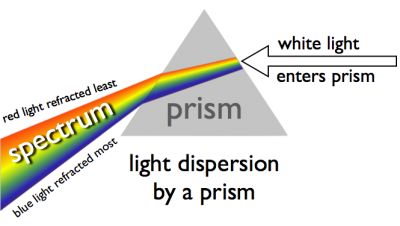

Notice the prisms in the following picture. The white lines omit the detail of the prism operation. They just show the path of the light. A hot black body, shown at the upper left is just a theoretical object that emits the full spectrum of light. Actually nearly nothing emits a continuous spectrum, not even the sun. Spectrums appear continuous until one spreads them way out and starts to look at the details. The more elements (hydrogen, oxygen, carbon, etc) a source has, the more complete the spectrum. The spectral images are obtained by the prism. When nearly full spectrum light hits a cloud of gas, certain portions are absorbed by elements in the cloud. These elements subtract part of the light falling into it, causing gaps in the spectrum coming out of it. This is called the absorption spectrum, as shown at the upper right. One the other hand, certain elements in the cloud, like hydrogen gas, emit the light that they absorbed. The spectrum of this emitted light is called an 'emission spectrum'.
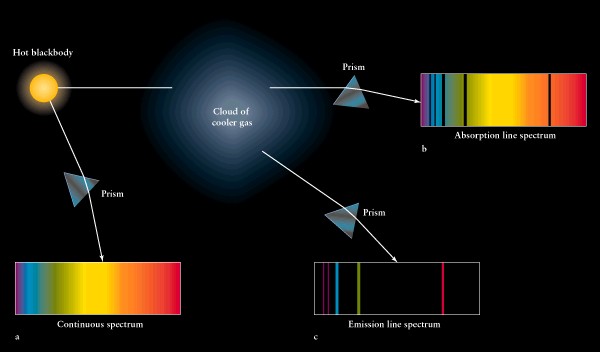
The spectrums of various elements are like bar codes. They show a unique signature for every element. For this reason astronomers can tell what something far away is made of. They just read the spectrum. The reason for the lines is that the atoms of elements emit light at fixed energy levels called quanta. The light emitted represents an electron falling from one orbital of an atom down to a lower one, and lower energy level. When the electron falls, it produces a photon of light unique to the electron's transition to the lower energy level. Every element has a unique set of energy levels. If one takes a large number of atoms of hydrogen, and excites their electrons in every possible way, then it re-emits the light at the specific pattern of hydrogen.
Hydrogen Spectrum:
|
|
|
Iron Spectrum: |
|
|
|
Nitrogen Specturm: |
|
|
The shift in red shift or blue shift is merely a moving of the pattern in the spectrum to the left or right. If it is a red shift, the lines will move toward the red. The line pattern stays the same for each element, but the shift causes the colors to change very slightly. If it is a blue shift, then the lines move slightly to the blue end of the spectrum. They also assume the color of that shifted position.
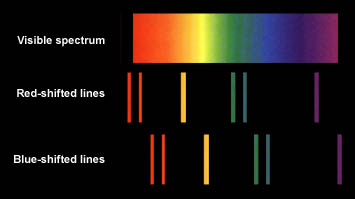
|
|
|
Idealized galaxy spectra showing typical ‘absorption’ lines (black against a rainbow-colored background) produced by hydrogen atoms absorbing light. The more distant the galaxy, the more the lines are shifted to the red side of the spectrum (log scale). |
Most galaxies are red shifted, but there are some with blue shifts also. These shifts represent a change from the normal spectrum as seen from the sun, or in elements tested on Earth. Something happens to the light on its way from the source to Earth. Increasing red shifts are seen in galaxies on all sides of the Earth with the increasing distance of the galaxy from the Earth. Red shifts are seen in binary star systems and gas jets.
Light is measured by its wavelength. Wavelength is only an analogy
with water waves, since light exhibits a comparable behavior. Visible
light lies in the range from 400 nm to 700 nm (nano-meters). A nano-meter
is one billionth of a meter, i.e. 1 x 10-9 meter. Green
light's wavelength is 510 nm, or:
 . You can
see in the picture below that 510 nm lies just to the right of 1x10-5
cm. The exponent means 0.000051 cm.
. You can
see in the picture below that 510 nm lies just to the right of 1x10-5
cm. The exponent means 0.000051 cm.
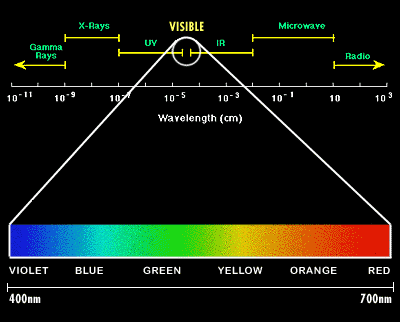
Light waves are often represented by a sine wave, with the wavelength of the sine wave varying for different wavelength of light. The blue sine wave below gives you some idea. The sine wave representation is purely a mathematical idea to describe some apparent properties of light.
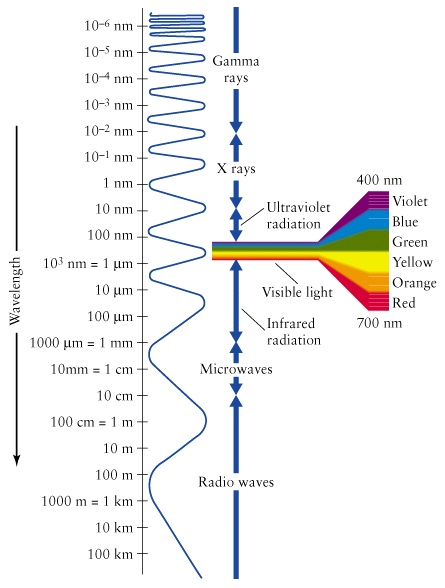
We know that at least part of the red shift is caused by the star or galaxy speeding away from us. Since red light has a longer wavelength than blue, a red shift means that the wave length of the light stretches out. Remember that these sine waves are purely mathematical representations of part of light's wave like properties. There is much that we do not know about light. No one has ever seen an an oscillating photon, nor has anyone every seen the wave function of light. The mathematical representations are merely the best guess we have as to quantified behavior of the light.
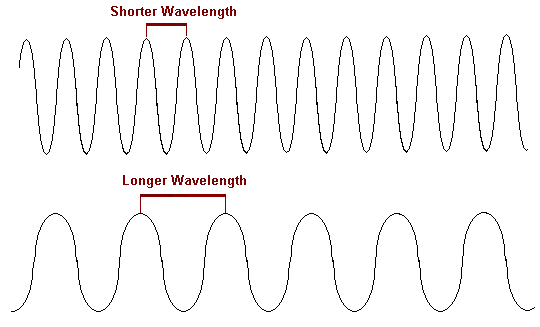
What happens when the light source is speeding away is that the gaps between the waves arriving at the destination seem to grow in length. When this occurs with sound, it is called 'Doppler Shift'. A high pitched siren on a police car approaches. The sound wave are very close together. It passes you and the pitch lowers dramatically. The sound waves are now arriving at your location more spaced out. This is called the Doppler effect. The animation shows how air molecules bang into each other to create sound.

The gaps and frequencies between the compressions create the sound, or to put it more accurately are decoded into the various sounds we hear by our ears. A sound wave is a longitudinal wave. A traverse wave looks like this:

The wavelength is the distance from peak to peak, or from compression point to compression point.
A binary star system is a star with a companion star. They orbit each other very closely, and sometimes very rapidly. The shifting of the light can be measured and depends on whether the star or its companion is approaching or receding in its orbit. This has led astronomers to interpret red shift as a kind of Doppler effect, indicating that the objects are receding from us at various velocities. Somehow the light waves are stretched out.
Another type of red shift is called "cosmological red shift". This means that the degree of red shift is correlated with the distance of the object away from Earth, whether it is moving or not. The correlation is an increasing red shift with distance. The "Hubble Constant" gives a formula for calculating 'cosmological red shift'. Another type of red shift occurs when light has to pass through a gravitational field. It is called gravitational red shift. Also red shift often appears to be measured at specific intervals. This red shift is called quantized red shift. The various types of red shift are:
Doppler red shift caused by velocity differences.
Cosmological red shift correlated to the distance of the object.
Gravitational red shift caused by energy loss in a gravitational field.
Quantized red shift due to red shift measurements clumping around periodic values.
All red shift is measured by the analysis of the spectrum shifts of the observed objects. Which red shift or combination of red shifts are represented by the observation is a complex matter of interpretation. Independent velocity can only be confirmed in a few cases. Gravity fields may not be seen. The explanation for quantized measurements is not clear. Clearly red shifts come with a variety of causes, all having to do with a loss of energy in the wavelength of light (i.e. longer) or an apparent loss of energy due to velocity. Or could the red shift be caused by a sum of infinitesimal energy loses accumulated due to acceleration and deceleration?
It has often been assumed that a change in the speed of light requires a red or blue shift. This might be true, but not necessarily to a large degree, because if light normally changes velocity outside a star system, the red shift may be more a measure of the inefficiency of the transition than a measure of the total change in speed.
There is one more variation of dynamical light speed variation that I would like to mention. I call this idea ID-VSL, for intelligent dynamical varying speed of light. This theory suggests that the behavior of light is axiomatic and that it is like an automata that gathers information at infinite speed. It then adjusts its own speed as it determines conditions. An automata would be like a photon sized robot ship that carries information or energy. This idea has some support from Quantum Mechanical Theory.
Quantum mechanics often mystifies us as to how light knows certain things. It is likely that the information speed of the universe is instantaneous, and not tied to the speed of light, or that the speed of light is really infinite and that the finite speed we measure here in the solar system is merely because it is delayed by the Zero Point Energy medium, or perhaps because the wave function has a long range sensing ability. Knowing how fast to go under certain conditions may make light photon's into information collecting automata. That indeed would be a problem for Unbelief, but not for creationists.
In summary, if light changed speed in the past, God could have done it without leaving any trace that it changed speed. God's designs in this realm could totally elude us. If light changes speed in deep space, it could happen without us seeing any effect of it in the light. Science would not be able to prove or disprove it. Cosmologists have tried to prevent speculation outside their religious dogma by involving the speed of light in many of the fundamental equations of physics. By tying everything together they have made all the properties of space and time interdependent such that there can be no independent properties. They then observe a few local properties and chain everything together in a determinism that prevents their opponents views. Their approach to science assumes that everything can be unified because it has a simple unified cause. However, in a universe created by a complex God, we expect complexity. And we expect the information content of the designs and complexity to be parallel dichotomous pieces of reality. We do not expect all designs to be derived from other designs in some kind of deterministic chain. Yet that is what fallen mankind wants to believe, because they have denied the eternal Almighty God.
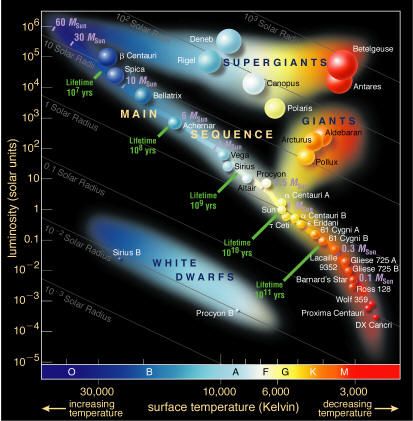
Let us relate the
first three points such that at first the speed of light was sufficient to
transmit all information instantaneously from the farthest points of the cosmos.
Let us now suppose that during creation God accelerated different parts of the
cosmos, i.e. sped up their atomic clock rates and gravitational clocks, such
that galaxies, stars, dust clouds, star clusters, and other bodies undergo
different rates of change and development. As seen on Earth through
a large telescope, the heavens would appear to be in differential states of
motion and speeds. With such differential rates of physical
processes, each star may have gone through part or all of the 'main sequence'
(see diagram above) before it arrived at its final created state.
God could have created without using the 'main sequence', on the other hand.
Cosmologists provide us with the physics necessary to produce different clock
rates, so if they insist on the Hertzsprung-Russell process for a particular
star, then gravitational clock slowing will keep Earth time within biblical
values.
Let us now suppose that when
creation ended, that these differential clock rates in the heavens ceased, and
that they synchronized with Earth's clocks. Let us also
suppose that God adjusted the speed of light downward from instantaneous such
that it assumes a constant velocity of finite speed some distance after emission
and some distance before absorption, but that it retains its relatively infinite
speed between. Is there any physical law that says we must be able
to see a physical effect of such a speed change? The answer is no!
Consider a telephone call across the world. Can the people on each
end of the line detect the distance by listening to the contents of the
conversation? Not all all. It makes no difference how fast the
information goes in between so long as it arrives at an intelligible rate at
both ends of the line. The information flows at the speed of light
down the line, and then when it enters the air, it slows down to the speed of
sound. It is emitted at the speed of sound from the source person.
When the information enters the receiver it accelerates to the speed of light.
When it arrives at the speaker, it slows to the speed of sound.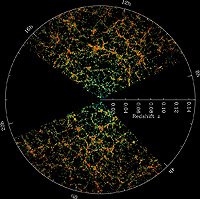
We may be seeing events in the farthest reaches in the Universe in something close to real time, perhaps even no more than a few days of delay. If the speed of light remains at the flat speed of 'c' or 299 792 458 meters/second for a few days of light time after either emission or a detection at some point, and then accelerates to a relatively infinite speed after that, then we would be seeing events in the heavens not too long after they actually happened. If this is possible, then it gives new meaning to at least one prophecy: And the stars of heaven fell unto the earth, even as a fig tree casteth her untimely figs, when she is shaken of a mighty wind. And the heaven departed as a scroll when it is rolled together; and every mountain and island were moved out of their places. (Rev. 6:13-14, KJV) It says, "heaven departed as a scroll". When the heavens roll up at the second coming of Messiah, it will happen on all sides. Wouldn't if be stunning to see a galactic super clusters roll up that are separated by thousands of mega parsecs? Such an event must have a singular cause, and must proceed at superluminal speed. The honeycombed picture above is from the Sloan Digital Sky Survey. Each little colored point represents a whole galaxy. The survey covered at least 930,000 galaxies. Imagine that structure rolling up from one end of the heavens to the other.
The following plot shows the periodicity of galaxy clumping to form walls symmetric to Earth. Taken with the Sloan Digital Sky Survey, it is a strong indication that the universe is only symmetrical with the Earth at the center of a series of concentric shells.
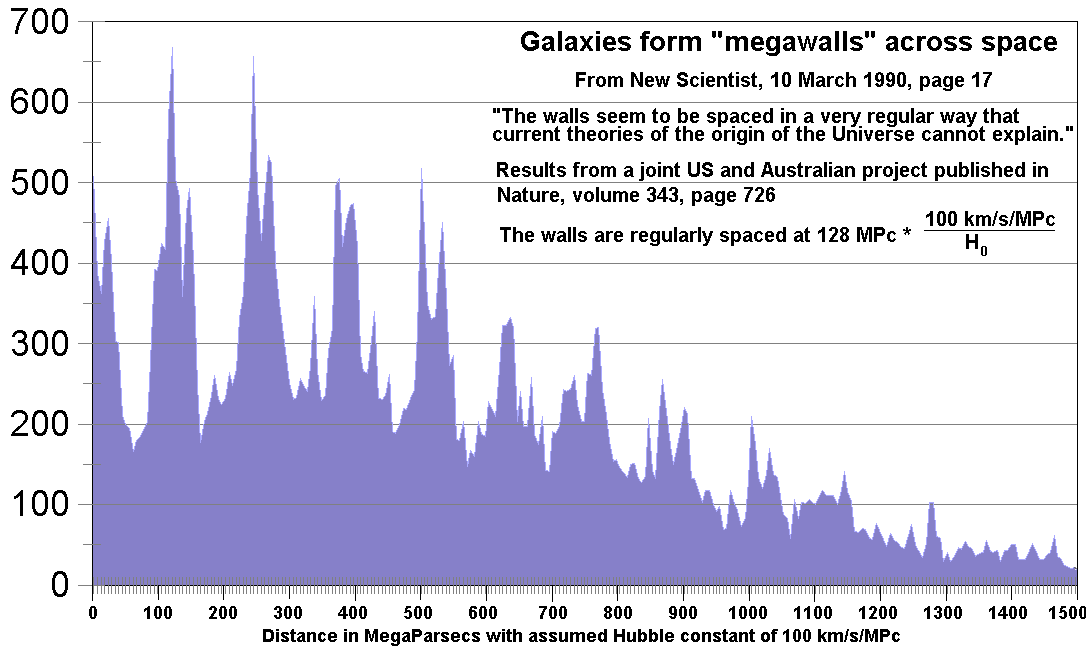
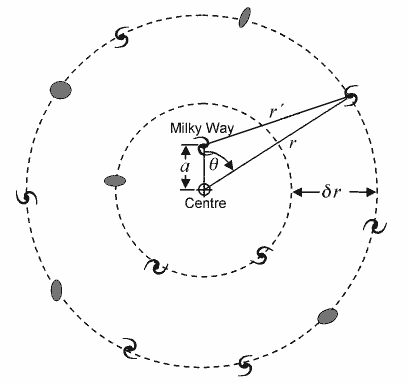
Russell Humphrey's explains that this points to an Earth centered universe. His figure shows the center near the Milky Way galaxy. However, there is no reason why the center might not be exactly at Earth. If it is probable that the center is that close, then it is no less probable that the center is exactly at Earth. Ding dong, the wicked witch is dead. I mean the Copernican Principle, along with the little goblin called homogeneity. It now appears that the universe is different at the center than elsewhere.
Scientists spend a good deal of effort looking for something to cause an observed effect. Unbelief assumes that there is always a cause to be found. True science, based on belief in God and his revelation in the Bible, allows that some observed effects are actually axiomatic properties. This means that they behave in a certain matter just because God said they must. Such properties are causeless in terms of other physics. Their cause lies in the power of the word of God, which is in the transcendent spiritual dimension. When God defines a physical property by his mere word, then that property is axiomatic. It cannot be reduced to the sum of other physical causes. This, of course, is the sort of miracle that Unbelief rejects, because unbelief rejects God.
However, there are many physical properties that are not axiomatic. But we do not always know how to distinguish between what is axiomatic and what is not. Unbelief thinks it can always assume that nothing is axiomatic in terms of being physically causeless. On the other hand, it assumes such causes as would contradict what God said. If it admits the mystical and ascribes some things to the transcendent dimension, then even here it does so in opposition to what God said.
The western world view is too much based on determinism. The eastern world view is too much based on indeterminism or the causeless. The east goes into anti-Biblical mysticism. It has a hierarchy of miracles, but no economy of miracles. The west was successful in finding a myriad of causes for everyday things because they first believed that God made intelligent designs, and ran the universe economically, i.e. with fewer miracles, or with an economy of miracles. Axiomatic physical properties based on the miracle of the divine word were embraced by the founders of western science. But then the west forgot God and believed in its own success, i.e. that a physical cause lay behind every bit of physics, and that the economy of miracles should be dismissed altogether.
Cosmic Expansion
The Cosmos seems expanding away from us at a speed of
 . This
means that for every mega-parsec one goes away from the earth, the speed of
expansion away from earth increases 72 km/sec. 2000 Mpc (mega
parsecs) into the heavens, the galaxies are receding at 144,000 km/sec.
That is about 50% of the local speed of light. This figure is based on the
Hubble "constant" interpretation of the red shift of starlight, also
called "cosmological red shift". This
red shift is a kind of 'Doppler effect' for light. The spread out light
waves toward the longer red end of the spectrum indicate that the source is
receding from us. One may wonder how this works out with a varying light
speed function. We merely have to assume that the varying light speed
function does not compensate for a difference in the speed of the source vs. the
observer. Or to put another way, the light knows the velocity
difference and shows it by stretching or compressing the wavelength of the
light.
. This
means that for every mega-parsec one goes away from the earth, the speed of
expansion away from earth increases 72 km/sec. 2000 Mpc (mega
parsecs) into the heavens, the galaxies are receding at 144,000 km/sec.
That is about 50% of the local speed of light. This figure is based on the
Hubble "constant" interpretation of the red shift of starlight, also
called "cosmological red shift". This
red shift is a kind of 'Doppler effect' for light. The spread out light
waves toward the longer red end of the spectrum indicate that the source is
receding from us. One may wonder how this works out with a varying light
speed function. We merely have to assume that the varying light speed
function does not compensate for a difference in the speed of the source vs. the
observer. Or to put another way, the light knows the velocity
difference and shows it by stretching or compressing the wavelength of the
light.
Locally, we know that the speed of light equals its frequency times the wavelength, such that:

Each wavelength of light is equivalent to a unit of information, which we must take in discrete packets called quanta. It is also a unit of energy. Consider two points in space, A and B, and the quanta of light represented by "~". Then:
A~~~~~~~~~~~~~~~~~~B
represents our formula when all the ends of the wavelengths are connected. But if the light changes velocity in the middle then:
A~~ ~ ~ ~ ~ ~ ~ ~ ~ ~ ~ ~ ~ ~ ~ ~~B
Observe that in this second case
that the wavelength has not changed, just the spaces between the waves (or we
may say the time delays by the ZPE decrease).
Likewise, the frequency at A and B have not changed either.
However, if we try to calculate the speed of light with the formula,
 , then you will end up with the
wrong answer for any point far from A or B. The formula assumes the
connectedness of the light waves as if it were being transmitted in a continuous
medium. The problem is that such an ether or medium has never been
observed. Light has wavelike properties, but that does not mean it
has all the properties of a water wave, like continuous connectedness in a water
medium. Light is called a 'self-propagating' electromagnetic wave, yet
each quanta of light appears to have an infinite 'wave function' or 'pilot wave'
that seems to know where it is going with a good deal of accurate probability.
, then you will end up with the
wrong answer for any point far from A or B. The formula assumes the
connectedness of the light waves as if it were being transmitted in a continuous
medium. The problem is that such an ether or medium has never been
observed. Light has wavelike properties, but that does not mean it
has all the properties of a water wave, like continuous connectedness in a water
medium. Light is called a 'self-propagating' electromagnetic wave, yet
each quanta of light appears to have an infinite 'wave function' or 'pilot wave'
that seems to know where it is going with a good deal of accurate probability.
If a light quanta '~' determines a velocity difference between A and B, then more space is being put between A and B the varying speed of light function accounts for. The light quanta therefore stretches to take up some of the excess space or contracts if A is approaching B. This then explains how a 'Doppler' red shift or blue shift is compatible with a varying speed of light.
Now we come to the question of whether the Cosmos is still expanding. God "stretched out the heavens" when he made them. So either the red shift shows this expansion directly, or it is a residual left over of expansion from a greater previous expansion. I believe that some expansion is left over, and that the record of the initial expansion has effectively disappeared due to the higher speed of light at that time.
At 4166 Mpc from earth, the average speed of recession would be the speed of light:

If light were traveling at speeds as measured on Earth (or between Jupiter and Earth) the whole way, then it would take billions of years in earth time to make the trip:

That would be 13.5 Billion light years. Of course, this is only a hypothetical calculation, assuming that light would have to go that speed the whole distance. This is the exact assumption that the high priests of New Babylon make for their cosmological religion. (Pardon me, I meant to say modern astrophysicists.) Biblically, we need say no more than that the heavens are stretched out to about 5000 Mpc. A Mega parsec is 1 million parsecs, and a parsec is an absolute unit of measurement equal to:
1 Parsec = 3.08568025 × 1016 meters |
The reason we measure the heavens by parsecs is that it does not involve the misleading concept of the time needed for light measured near the earth to traverse these distances. I will call the modern astrophysical cosmologists who reject Biblical revelation the New Babylonian Cosmological Priests, Cosmological Priests, or just Priests to emphasize the religious nature of the cosmologies they promote. This is not meant to needlessly insult them, but merely to put truth in perspective, crediting their views with religious dogma rather than true science. Of course, this is my religious point of view on them, but the difference is that I claim my religion and supporting science are true, while theirs is false. We may also say their their views are philosophically motivated, but this is no different than religion.

|
| The galaxy cluster Abell 1835 behind which the galaxy Abell 1835 IR1916 was discovered. Distance 4000 mega parsecs (13.23 billion years at the local speed of light). |
The cosmological priests limit the size of their universe to 13.5 Billion light years. The reason for this is clearly because if the universe were any larger, the Hubble expansion would extrapolate to greater than the speed of light:

Any size much in excess of 4200 Mega parsecs will yield an recessional velocity that exceeds the speed of light. Anything in excess of the speed of light is unacceptable to the censorious priests. A fixed and immutable speed of light is a canonical axiom of the Babylonian priesthood. It was chosen for its precise incompatibility with the Divine Creation account in Genesis 1, and the revealed age of the Earth.
They consider the
local speed of light as proof for the speed of light for the whole universe.
This view is scientifically close minded as well as scientifically wrong.
The Sagnac Effect demonstrates that the speed of light varies when the source is
moving relative to the local gravitational field. Georges Sagnac
redid the Michelson–Morley experiment. The Michelson experiment was
fixed to the Earth and did not detect the expected difference in the speed of light in
any direction. However, it did detect 8 km/sec. It was then assumed that the velocity of the Earth
about the sun would produce a difference in the speed of light in different
directions, i.e. exactly 30 km/sec. This difference was not detected, and the experiment was
considered a failure after many tries. What Georges did was put the
experiment on a rotating platform so that the light would be moving with respect
to the earth. Amazingly the experiment detected a difference in the
velocity of the light depending on the rate and direction of rotation.
Apparently, a light speed difference is detected when light is moving against a
gravitational field. Sagnac himself concluded that the speed of light
varied. Similarly an atomic clock will slow down when it has a
relative velocity in a gravitational field. This was proven when atomic
clocks were flown on jets and then returned to Earth for comparison with
stationary clocks.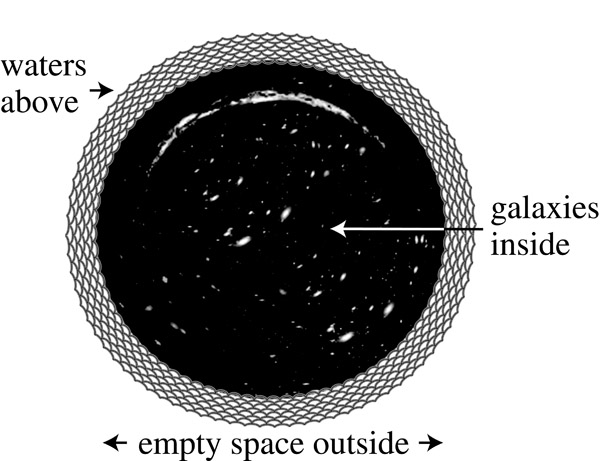
Now we may use these effects to construct a Biblical Cosmology. The "waters above" were the substance out of which the stars and galaxies were made. As God made the heavens, he also stretched them out. If we put the diameter of the deep at 1 parsec, then all the matter in the known universe will fit into this small sphere, essentially inside a non-compact black hole, where the gravitational law acts instantaneously. Since water is 1 gram per cubic centimeter, which is only 1/5th the density of Earth's rocks, and since the portion to become the Earth is at the center, it would not be crushed by the force of the gravity. Only the outer part of the sphere would begin to accelerate inward, but it would not be allowed to continue into the ultimate black hole. What God did is to expand the space or reverse the process. This may be compared to a 'white hole'.
On the second day, God
divided the waters above from that below. The waters above were further
sub-divided, though the text does not explicitly say that, into seas, clouds,
water for the stars and galaxies, and water for the third heaven. We may
assume that space was expanded somewhat in this process of separation, enough to
reverse the gravitational collapse of the sphere and to put the earth in the
hollow at the center, which would become a zone of zero net gravitational
acceleration.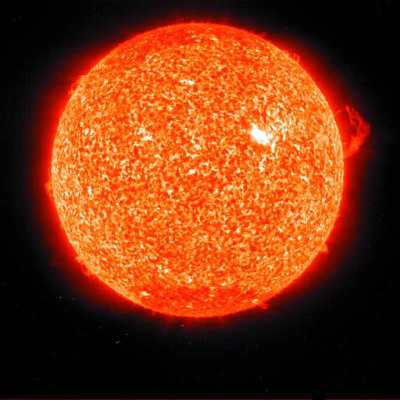
However, the
gravitational field is still present at the center. Let us now fast
forward to the beginning of day four. First God forms the sun and the
moon. The sun is 8.3 light minutes away from the earth.
No problem here. He takes some of the water to form it.
Likewise with the moon. He then forms the other planets. God
begins to rotate the unused mass of waters. The waters form their own
inertial frame even though rotating, so there is no centripetal force at the
surface of the sphere. The waters accelerate until the rotation rate
is equal to one day. God holds the Earth stationary, while the
sun is dragged into the inertial frame of the unused waters.
As the planets are formed God moves the hollow sphere of unused waters outward just enough to form each planet. He then moves the sphere to the radius of Proxima Centauri (4.22 light years at current light speed). When he does this the earth and everything in its vicinity ceases to move. Atomic processes freeze. They are suspended. Electrons halt in their orbits. The moon does not orbit. A clock on earth would not tick a single second. What happened? The gravitational field of the great mass of the waters has now been accelerated as the heavens are stretched out relative to a stationary Earth such that the gravitational field is moving at many times the current local speed of light through the Earth. The Earth is at the center, so the accelerating component of gravity has no affect. However, the field itself is moving, and like the Electro-Magnetic field, it also has a clock slowing component that takes effect when the field moves. This is analogous to an electric current creating a magnetic field at right angles to the electric field. Only if the electric field is oriented correctly is a magnetic field produced. Likewise the accelerating component of gravity at the center of the hollow sphere is zero, but the clock slowing component is not zero. In fact, the heavens are being stretched out at relativistic speed such that the field is moving through earth fast enough to freeze all physical processes in its small region. I also suggest that this moving field is even more intense since the component fields on opposite sides of the sphere are moving away from each other. The accelerating components cancel out, but the clock stopping components reinforce.
Opposite sides of the sphere do not mutually cause a slowing. Why? Because gravity decreases with the square of the distance, and after 10kpc only with the distance. We might call the clock slowing component the 'normal component'. The normal component is relatively weak when competing against a massive field in another direction, which sets its own inertial frame of reference.
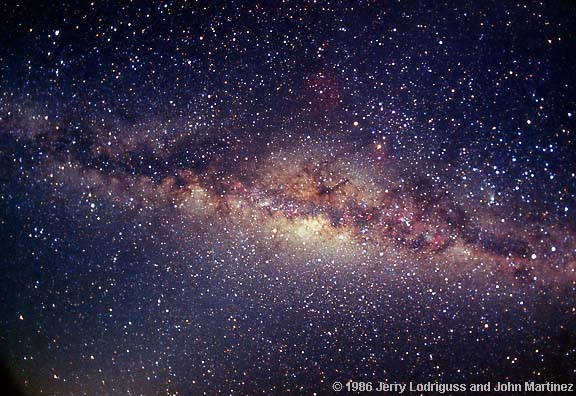
So while the earth is in suspended animation, the arms of the Milky Way Galaxy are created. The Galactic Center is created, and God sets up a mechanism for it to birth more galaxies. It ejects two Quasars in opposite directions, which form into galaxies (according to Halton Arp). He creates clouds and star clusters. As the comic clocks are accelerated with respect to earth, light almost reaches earth, but then also God is done with the local galaxy, he slows the expansion down a little and speeds up the expansion of the unused waters. Now there is a clock differential between created objects nearer to Earth vs. those farther away. When the massive gravity field of the waters expanding outward ceases to move with respect to the Earth, then all the clocks instantaneously synchronize.
We now have to consider what happens to a stream of light information streaming into the local gravity field of the Solar system where the source gravity field is moving away at super velocities. Let us represent this situation like this:
E~~ ~ ~ ~ ~ ~ ~ ~ ~ ~ ~ ~ ~ ~ ~ ~ ~ ~ ~ ~ ~ ~ ~~~Cosmos
Essentially, there is more information than Earth can process piling up on its doorstep so to speak. There is more energy piling up too. But here we must allow for special processes during creation. I'll make an analogy to what is needed here. Consider that a filmstrip is composed of many still photos.

It is not a continuous record of motion for every infinitesimal change in the source. Our quanta '~' are like the still shots in the filmstrip. Now of course, extra space is being added by the outward velocity of the Cosmos. This alleviates part of the problem. Part of it disappears as the waves themselves shorten in blue shift. I propose that if still too much information and energy remains that it is absorbed into the Zero Point Energy field (ZPE) and instantaneously averages out over the entire universe. This is simply equivalent to chopping more and more still shots out of the filmstrip. The Earth observer would see a highly accelerated motion, but at no higher speed than he could handle. All God would have to command or program by his word would be the proviso that in the case of two gravity fields speeding apart that energy and information from the stronger field that enters the weaker field where atomic processes are retarded is simply discarded into the ZPE field such that the parameters of wave connectedness, energy absorption rates, and possible wave shifts are not exceeded.
This, of course, is the solution to sending energy-information down into a black hole, where clocks essentially are stopped. According to Stephen Hawking it can't get out. According to others the energy-information is locked up for eternity. According to others (the heretics) it leaves at superluminal speed. The problem is easily solved by redistributing it by whatever faster than light mechanism you wish -- only let's be clear, such information is being discarded into the randomness of the ZPE field, and ceases to be information.
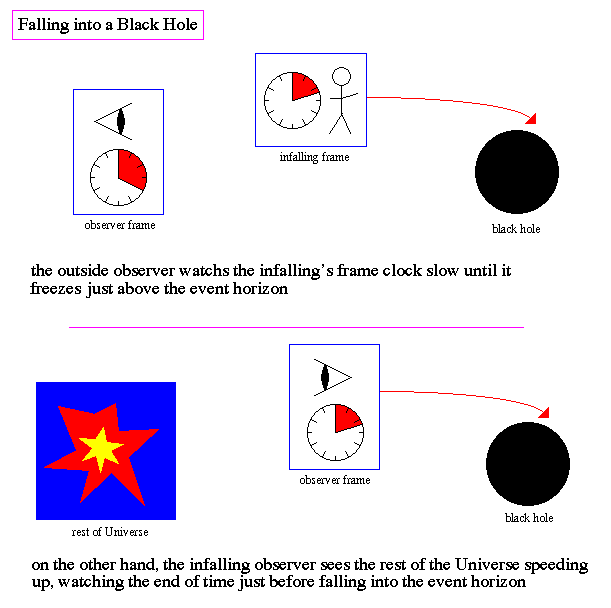
 Further, the objects
at the Edge of the Universe have 'aged' more than those nearer because their
clock time was accelerated on a trajectory away from the center, even though the
more 'aged' objects were created last! Try to think of that Star
Trek episode where members of the crew had a potion dropped in their coffee that
accelerated them (Wink
of an Eye). When they drank it, the rest of the crew froze in
position. If they fired their phaser, they watched it slowly creep through
space. Watch it. Or how about that episode when the crew
was exposed to a radiation that
artificially 'aged' them till they had premature grey hair in a matter of hours
(The Deadly Years, Dec. 8, 1967, Season 2). Notice the photo of
Kirk with premature aging.
Further, the objects
at the Edge of the Universe have 'aged' more than those nearer because their
clock time was accelerated on a trajectory away from the center, even though the
more 'aged' objects were created last! Try to think of that Star
Trek episode where members of the crew had a potion dropped in their coffee that
accelerated them (Wink
of an Eye). When they drank it, the rest of the crew froze in
position. If they fired their phaser, they watched it slowly creep through
space. Watch it. Or how about that episode when the crew
was exposed to a radiation that
artificially 'aged' them till they had premature grey hair in a matter of hours
(The Deadly Years, Dec. 8, 1967, Season 2). Notice the photo of
Kirk with premature aging.
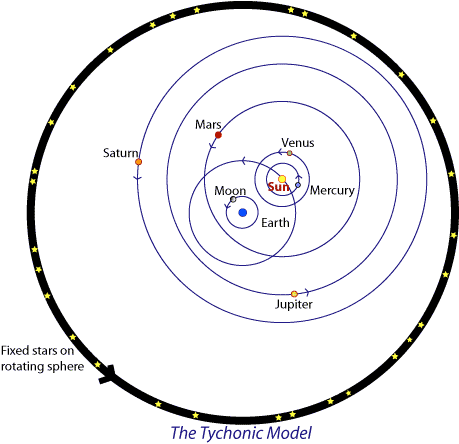
|
Tycho Brahe revised Ptolemy's model by making all the planets go around the sun, and then the sun go around the earth. Tycho's model, despite its flaws, suggests that the universe may be described correctly with geometry from Earth's point of view. The possibility of alternative explanations of parallax, Foucault's pendulum, coriolis forces, and tidal effects, etc., still exists. Science has not disproved these explanations, so it is still possible for the earth to be at the center of the universe. It is only for philosophical reasons that many consider the idea improbable, not for lack of a way to describe it. |